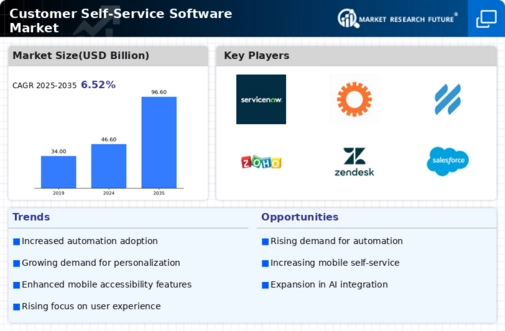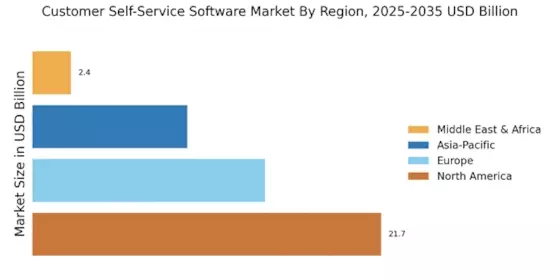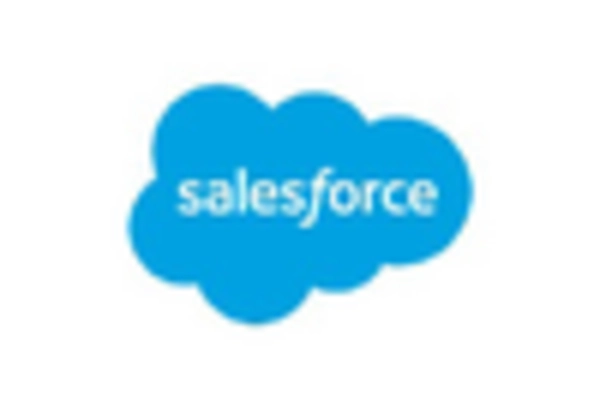Increased Customer Expectations
In the Customer Self-Service Software Market, there is a marked increase in customer expectations regarding service delivery. Modern consumers demand immediate access to information and solutions, which has prompted businesses to adopt self-service software as a means to meet these expectations. Data indicates that 70% of customers prefer to use self-service options for simple inquiries, reflecting a shift in consumer behavior. This trend is further fueled by the proliferation of digital channels, where customers expect seamless interactions across platforms. As businesses strive to enhance customer experience, the integration of self-service solutions becomes essential. By providing customers with the tools to find answers independently, organizations can improve satisfaction levels and foster loyalty. This growing emphasis on customer-centric service models is likely to drive further investment in self-service technologies.
Rising Demand for Cost Efficiency
The Customer Self-Service Software Market is experiencing a notable surge in demand for cost efficiency among businesses. Organizations are increasingly seeking solutions that reduce operational costs while enhancing customer satisfaction. According to recent data, companies that implement self-service solutions can reduce customer service costs by up to 30%. This trend is driven by the need to allocate resources more effectively, allowing businesses to focus on core activities. As a result, the adoption of self-service software is becoming a strategic priority for many organizations. The ability to empower customers to resolve their issues independently not only leads to cost savings but also fosters a more engaged customer base. This shift towards self-service capabilities is likely to continue, as businesses recognize the long-term financial benefits associated with these technologies.
Shift Towards Omnichannel Support
The Customer Self-Service Software Market is witnessing a shift towards omnichannel support, which is reshaping how businesses interact with customers. Organizations are increasingly adopting self-service solutions that integrate multiple channels, allowing customers to switch seamlessly between platforms. This approach not only enhances the customer experience but also provides valuable insights into customer behavior. Data shows that companies with omnichannel strategies retain 89% of their customers, compared to 33% for those with weak omnichannel engagement. As businesses strive to create a cohesive customer journey, the demand for self-service software that supports various channels is likely to grow. This trend indicates a broader recognition of the importance of providing customers with flexible options for accessing support and information.
Regulatory Compliance and Data Security
In the Customer Self-Service Software Market, regulatory compliance and data security are becoming increasingly critical. As organizations handle more customer data, the need to comply with regulations such as GDPR and CCPA is paramount. Self-service software solutions that prioritize data security not only protect customer information but also build trust with users. Recent studies suggest that 60% of consumers are concerned about how their data is used, making it essential for businesses to adopt secure self-service technologies. By ensuring compliance and safeguarding data, organizations can mitigate risks and enhance their reputation. This focus on security is likely to drive the development of self-service solutions that incorporate robust security features, thereby addressing both regulatory requirements and customer concerns.
Technological Advancements in Software Solutions
The Customer Self-Service Software Market is significantly influenced by rapid technological advancements. Innovations in artificial intelligence, machine learning, and natural language processing are enhancing the capabilities of self-service software. These technologies enable more intuitive user interfaces and personalized experiences, which are crucial for customer engagement. For instance, AI-driven chatbots can provide instant responses to customer queries, improving response times and overall service quality. The market for AI in customer service is projected to reach substantial figures, indicating a robust growth trajectory. As businesses increasingly recognize the potential of these technologies, the demand for sophisticated self-service solutions is expected to rise. This trend suggests that organizations will continue to invest in advanced software to stay competitive and meet evolving customer needs.


















Leave a Comment